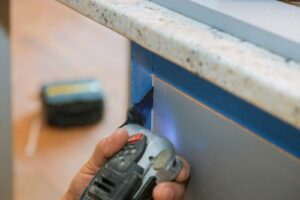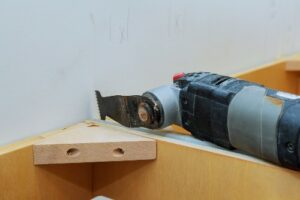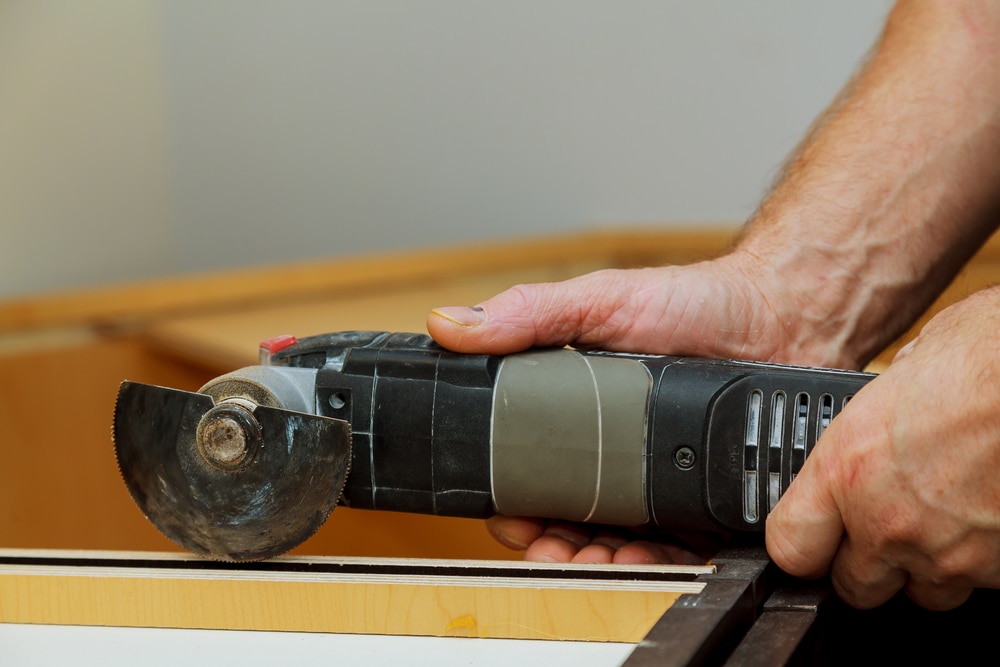Last Updated on January 10, 2023
For those interested in DIY, there is a huge range of tools available. You can easily spend hundreds on a set of tools including sanders, drills, circular saws, and more. But what if you can get one tool that can perform many of these functions? Enter the multi-tool. An oscillating multi-tool is an incredibly useful device that can be used for multiple DIY purposes. It is a versatile tool and great for both home usage, or work on site.
Regardless of what job you have to complete, this accessory could make the perfect tool. You may, however, be unsure as to what is a multi-tool. Fear not – we explain what is a multi tool, what it can be used for, how it works, and how to choose one below!
The Multi-Tool Explained
A multi-tool is also known as an oscillating tool or an oscillating multi-tool. It is essentially a power tool that can perform a variety of functions due to the different attachments and accessories it can have. Hence the name multi-tool – it can be used for multiple jobs!
This product has a motor that causes oscillations in the tool head. The oscillations or vibrations are what gives the device its power to perform the different tasks. Different accessories are then added to the tool allowing you to perform various functions and DIY tasks.
For example, when using a reciprocating saw, the vibrations are what cause the back and forth motion and allow the blade to cut. Alternatively, if using a scraper blade, the vibrations cause friction and thus allow you to easily remove layers from the surface you are scraping.
These tools are also usually handheld and small enough to operate singlehandedly. You can get both cordless and corded multi-tools. Also, you can get different powered motors, and even tools that have variable vibration speeds.
What DIY Tasks Can You Use a Multi-Tool For?
You should now have a basic idea of how these devices operate. But what can they be used for? After all, the term “multi-tool” is quite generic and doesn’t really give the user an idea of what you can do with one! To help, we have listed some of the common ways that you can use these tools below:
- Trimming objects like pipes, screws, and bolts
- Making plunge cuts in wood and decking
- Trimming new flooring, floorboards, and wood
- Cutting and shaping drywall before plastering
- Removing rust from metal surfaces
- General sanding
- Removing adhesive from tiles and carpets
- Grout removal from bathrooms and kitchens
- Removing old paint from surfaces
- Grinding mortar from breeze blocks and bricks
This is not a comprehensive list, and there are many more ways you can use these devices. However, the above gives a good general overview of what you can do. To provide additional detail, we talk about the three main functions you can use this tool for below including cutting, sanding, and removing.
Cutting
Primarily, these tools can be used for flush cutting. They yield excellent results due to the way the vibrations move the metal cutting blade attachments. You can get a range of blade attachment accessories including a circular saw blade, a carbide blade, and a plunge saw.

Regardless of the metal cutting blade type, you can use these devices to effectively cut through a myriad of materials including wood, metal, plastic, drywall, and even concrete.
Also, you can utilize the multi-tool to cut in a variety of ways. For example, you can make plunge cuts into wood. Also, you can use it for flush cutting if you need to trim pipes, or wood panels down to size. The cutting motions are easy to control, and you are given an excellent degree of accuracy.
Aside from making a plunge cut or notch cuts in wood, you can even use the cutting blade to cut floor files and carpet sections. Cutting floor tiles can be incredibly difficult, and it can be challenging trying to get a straight cut. This type of device, however, allows you to cut the tiles smoothly, and even cut corners if needed.
Sanding
Next, most oscillating tool devices will also have a head that you can attach a sanding pad to. The oscillating motion and vibrations are perfect for sanding. As a result, you can use these tools to sand both metal and wood, as well as other surfaces.
Instead of purchasing a dedicated orbital sander or palm sander, you could buy an oscillating multi-tool instead and save on much of the expense. It still offers a fantastic sanding function and will perform just as well as a dedicated handheld sander.
Due to the shape of the sand head and tool, you can also reach difficult areas and sand in places that you may not be able to with a traditional sander, or manually using sandpaper. If you want an oscillating multi-tool primarily for sanding, we advise checking the sanding head first. Look at what types of sandpaper you can attach. Also, check if you can use third-party sandpaper, or if you are limited to the manufacturer’s accessories.
Removing
Lastly, the other main function of an oscillating multi-tool is “removing”. We use this as s generic term, but the basic premise is that you are using the vibrations to remove unwanted materials. The following are some of the “removing” tasks an oscillating multi-tool can perform:

- Grout removal from tiles
- Removing carpet adhesive ready for new flooring
- Removing old mortar from bricks and breeze blocks
- Removing old paint
Essentially, if you have some unwanted material on a surface, the scraper blade attachment will allow you to remove it effectively.
For example, you may have a piece of furniture or metal frame that has an old layer of paint that is chipped and cracked. Instead of simply painting over this, and potentially leaving an uneven surface, you could use the scraper blade of the oscillating multi-tool to remove the old paint. This gives you a clean surface to work with.
Alternatively, perhaps you want to re-grout the tiles in your bathroom. Maybe the grout has discoloured and is flaking in places. If any of you have tried removing grout manually, you know how difficult this can be! Using a multi-tool, however, the process becomes simple. You can quickly and effectively remove old grout without damaging the surrounding tiles.
Similarly, maybe you are installing new flooring in your living room. You tear the old carpet up, only to find that patches of adhesive are still present. Leaving this old adhesive could potentially interfere with the installation, and leave uneven surfaces. A multi-tool can easily be used to remove this unwanted adhesive and provide a clean surface ready for your new carpet or laminate flooring.
Also, less commonly, this type of device can be used to cut and remove old mortar from bricks and breezeblocks. Maybe you have a stack of old bricks from a previous build that are still in great shape and usable. However, they are covered in old layers of mortar which will make using them again difficult! The scraper of these tools will tackle the areas of old mortar effectively and give you a clean brick surface to re-apply fresh mortar!
How to Choose a Suitable Multi-Tool?
Now that you understand how oscillating multi-tools work, we can look at how to choose a suitable product. Before you choose one, you should first consider what you intend to use it for.
View this post on Instagram
Do you just want a versatile tool for your home workshop to help with occasional DIY tasks? Or maybe you need something more robust for your work and to take onto sites? Also, by understanding what you intend to use the device for, you can look at what accessories and blade options you require.
Consider this, and your choice should become clearer. Also, we have listed below, five main aspects of an oscillating tool that are important to consider:
Available Attachments
This again ties back to how you wish to use the multi-tool. However, as a bare minimum, we would expect the power tool to have a segment saw blade, a plunge saw blade and a base plate for sanding. These are the main functions of a multi-tool.
However, some manufacturers do offer a much larger range of multi-tool accessories. For example, Bosch has a large range of accessories that can allow your tool to tackle specialist tasks like removing carpets and removing concrete residues. It has something for everything, whether you want to sand flooring or cut tiles.
Motor Power and Oscillating Rate
Next, consider the power of the device. What motor does it have? What maximum oscillation rate does it provide? Can you adjust the oscillation rate or does it have a fixed speed? These are important technical details you should understand as they will affect what type of jobs you can do with this accessory.
Generally, the main features to look for are the Amp rating, the oscillation angle, the OPM rate, and the availability of variable speed operation. The Amp rating is important to understand what overall power is input into the device, and what power outlet it may need. Also, the OPM rate (oscillations per minute) is highly important as this denotes the vibration speed of the head.
Finally, look if the device has any variable speed operation which would give you greater control when completing a task. If you can alter the speed of the oscillations, you can better control the functionality of the device.
Ergonomic Design and Comfort
You must also consider if the multi-tool is easy to use and comfortable to use. When using an oscillating tool, it can present safety hazards, especially if you are using attachments like a circular saw or sanding pad. Also, the power tool vibrates quickly and thus can put a strain on your hands and fingers and possibly lead to complications.
Primarily, you should look if the tool has any safety features like a guard, or vibration reduction to reduce the strain on your hands and arms. Also, look at the shape of the multi-tool, and the handle – does it look comfortable to hold, and will it be easy to use?
Charging and Power

Next, look at the power source. You can get both cordless and corded multi-tools. Both have their advantages and drawbacks.
Corded multi-tools offer better longevity and you can use them for more difficult tasks without the need to continually recharge a battery. However, the downside is that you are limited in terms of movement and the length of the power cable in relation to the closest power outlet.
On the flip side, a cordless oscillating multi-tool offers greater freedom. You can move about and use the device anywhere. Also, these devices are easier to store due to the lack of a cable. However, you must consider the battery life, and the charging time – these can often slow down your work and you may need to make regular recharging stops.
Maintenance
Finally, now that you already have an idea of what is a multi tool, you should look at maintenance areas and how easy the device is to look after. When using an oscillating tool, you will have to change the head attachment for different tasks. How easy is this process? Some tools have a simple locking mechanism and may include Allen keys to easily loosen the connection, for example.
Also, can the device and heads easily be cleaned? You must have the ability to quickly clear away excess material deposits from the head so that it operates smoothly and doesn’t jam.
Multi-Tool FAQs
Is a multi-tool worth buying?
Yes! These are versatile power tools that have multiple attachments and can be used for a variety of simple DIY jobs. Whether you want to work with door casings, need to remove unwanted objects, or cut different materials these are excellent tools.
Can you cut metal with a multi-tool?
Yes, depending on the power of the motor and the attachments that it comes with, this tool cuts metal.
Final Thoughts
Now we have told you what is a multi tool and what they are used for we hope you will have fun getting to know what it can do. Once you get to know the tool you will learn that there are so many different ways you can utilise it. Soon, you will be using your oscillating tool for all of your DIY jobs.
Let us know what you use your mutli tool for or if there are any uses that we have missed.
Paul is the type of person who never met a problem he couldn’t fix. He can always be found tinkering with something in his house, even if it isn’t broken! His tips and tricks are often shared on our site. He’s the one you call when something breaks because he has been known to improvise fixes for everything from leaky faucets to malfunctioning dryers.

